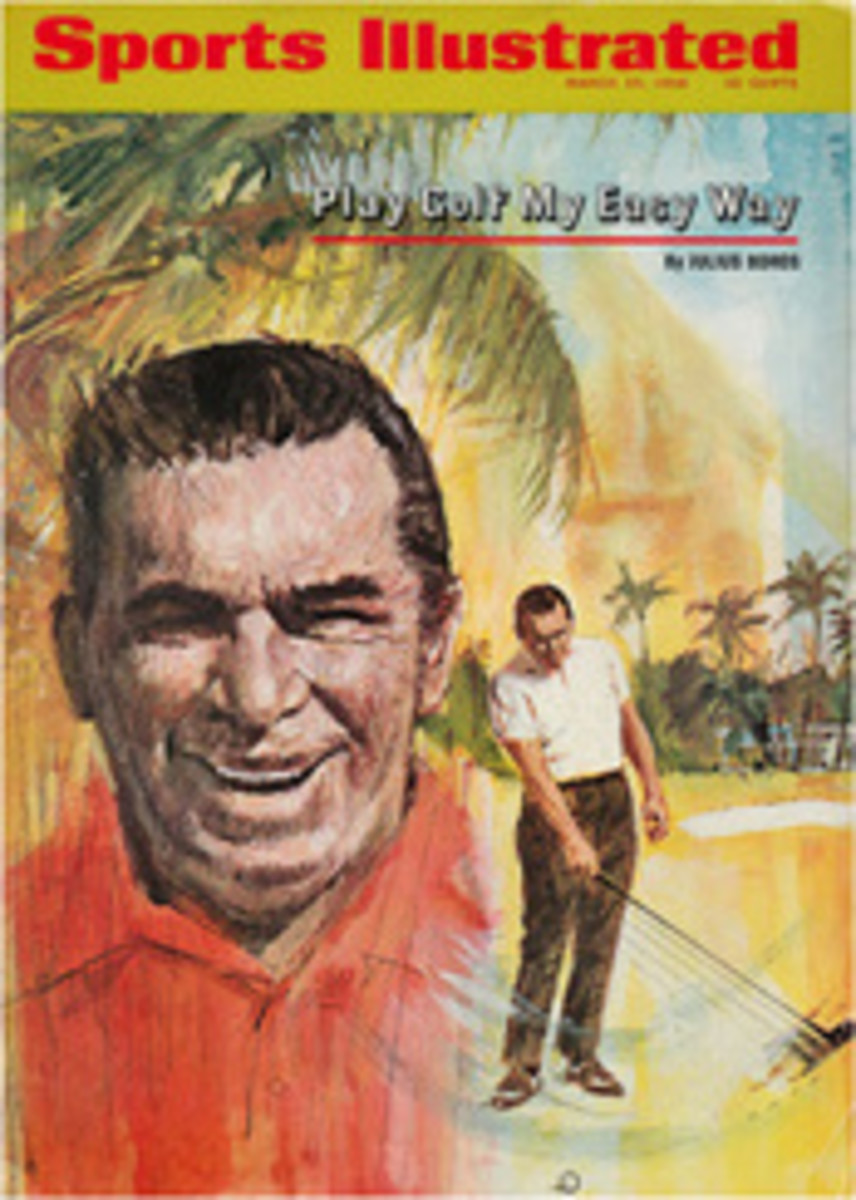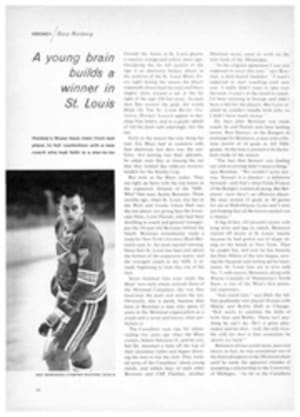
A young brain builds a winner in St. Louis
Outside the Arena in St. Louis gleams a massive orange-and-yellow neon sign. Occupying the far left section of the sign is an electronic hockey player in the uniform of the St. Louis Blues. Every night during the season the player repeatedly draws back his stick and blasts mighty shots toward a net at the far right of the sign 250 feet away. As each shot flies toward the goal, the words HOME OF THE ST. LOUIS BLUES—NATIONAL HOCKEY LEAGUE appear in dazzling blue letters, and in a gaudy splash of red the puck sails unerringly into the net.
Early in the season the only thing the real, live Blues had in common with that electronic hot shot was the uniform. Not scoring was their specialty. So adept were they at missing the net that they looked like odds-on noncontenders for the Stanley Cup.
But look at the Blues today. They are right up there with the top teams in the expansion division of the NHL. Why? One man. Scotty Bowman. Three months ago, when St. Louis was last in the West and Goalie Glenn Hall was the one player not giving fans the lowercase blues, Lynn Patrick, who had been doubling as coach and general manager, put the 34-year-old Bowman behind the bench. Bowman immediately made a trade for New York's Gordon (Red) Berenson and, lo, the team started winning. Since then St. Louis has been just about the hottest of the expansion teams, and the youngest coach in the NHL is already beginning to look like one of the best.
Some fanatical fans even claim the Blues' new-style attack reminds them of the Montreal Canadiens, the way they head-man the puck and storm the net. Obviously, this is partly because they have in Bowman a man who spent 12 years in the Montreal organization as a coach and a scout and knows what perfection is.
The Canadiens were ripe for talent-raiding two years ago when the Blues owners, Sidney Salomon Jr. and his son, Sid III, skimmed a little off the top of their insurance riches and began choosing the men to run the club. They wanted some of the Canadiens' sharp young minds, and within days of each other Bowman and Cliff Fletcher, another Montreal scout, came to work on the west bank of the Mississippi.
"In the original agreement I was just supposed to scout this year," says Bowman, a dark-haired bachelor. "I wasn't supposed to start coaching until next year. I really didn't want to take over the team. I wasn't in the mood to coach. I'd been scouting in Europe and didn't have a feel for the players. But Lynn insisted he couldn't handle both jobs, so I didn't have much choice."
Six days after Bowman was made coach, he and Patrick sent their leading scorer, Ron Stewart, to the Rangers in exchange for Berenson, a man with a lifetime record of 16 goals in 185 NHL games. At the time it seemed to be the ho-hum trade of the season.
"The fact that Stewart was leading our club in scoring didn't mean a thing," says Bowman. "We couldn't score anyway. Stewart is a checker—a defensive forward—and that's what Emile Francis of the Rangers wanted all along. But Berenson—now there's an offensive player. He once scored 23 goals in 30 games for me at Hull-Ottawa. Lynn and I were just hoping that all Berenson needed was a chance."
A big (6 feet, 185 pounds) center with long arms and legs to match, Berenson started off slowly in St. Louis, mainly because he had gotten out of shape sitting on the bench in New York. Then he caught fire, and now he has become the Stan Mikita of the new league, scoring the big goals and setting up his teammates. St. Louis fans are in love with No. 7, with reason: Berenson, along with Wayne Connelly of Minnesota's North Stars, is one of the West's first potential superstars.
"Just watch him," says Hall, the All-Star goaltender who played 10 years with Mikita and Bobby Hull in Chicago. "Red seems to combine the skills of both Stan and Bobby. There isn't anything he can't do. He's a great play-maker and his shot—well, the only trouble with his shot is that sometimes he shoots too hard."
Berenson always could skate, pass and shoot; in fact, he was considered one of the finest prospects in the Montreal chain until he made the apparent mistake of accepting a scholarship to the University of Michigan. "As far as the Canadiens were concerned, Red was going to waste four of the most critical years in his development," says Bowman. "They didn't want him traipsing off to play hockey in the States. When he came back—with just about every record in his league—he was tabbed as just another American who wouldn't stand up to the beating he would get in the pro game."
For the next five years Berenson shuttled between the Canadiens and their farm teams, playing for Bowman at Hull-Ottawa in 1962-63. After the 1966 season he was traded to New York.
"I never got started with the Rangers," he says. "First I broke my foot. Then I broke my cheekbone. By the time I was ready to play, the team was going good and Emile wasn't about to change it around for me. Last fall I asked Emile if he would trade me."
"I remember a plane trip I made with Emile last spring," says Bowman. "He said that someday, somewhere, Berenson was going to make somebody a helluva hockey player. He said he only wished it could be in New York." It has happened instead in St. Louis, to the surprise of neither Bowman, Francis nor Berenson himself—although few others in hockey expected any such miracle.
One day in December, Bowman handed 3-by-5 cards to the players during a team meeting. Bowman asked each man to write how many points he thought the team would score during the rest of the season and how many goals and assists he would personally contribute. "We were in fifth place with 23 points," Bowman says. "I told them we would probably need 68 to make the playoffs. The cards came back with modest predictions. A few had us missing the playoffs altogether. But Berenson! First he thought we'd get 50 points—good enough for first place. Then—even though he had only one St. Louis goal at the time—he predicted he would score 20 goals and 30 assists in the remainder of the season." Berenson, who has 22 goals and 26 assists for the year, has scored 19 goals and 20 assists since the day he filled out the card.
Without Berenson, says Bowman, the Blues would merely be playing out the season for experience. But without Bowman, say the experts, the team would have those blues you can't lose.
Bowman has the ability to handle each man as an individual, from the ultra-sensitive Hall ("If he doesn't throw up before a game, he's not ready") right on to the belligerent Plager brothers, Barclay and Bob. "Scotty just seems to understand us," says Berenson. "It's as simple as that."
Bowman says he understands hockey players because he played hockey himself. The truth of the matter is, he would probably be playing professionally today had not Jean Guy Talbot lost his temper 17 years ago and broken his stick over Bowman's head during a junior game in the Montreal Forum. "I was lucky," Bowman says with a wince. "The doctors said if the stick doesn't break, I'm dead." Bowman never played again, while Talbot, after being suspended for three years for clubbing Bowman, went on to 12 brilliant seasons as a defense-man for the Canadiens.
It was to talk about Talbot that Lynn Patrick walked into Bowman's office one afternoon this winter. "Scotty," he said to his coach, "Detroit has asked waivers on Talbot." Selected third by Minnesota in the expansion draft, Talbot subsequently had been traded to the Red Wings. He was 35 years old and sliding out of the NHL.
"He can still skate, can't he?" asked Bowman.
"I think so," replied Patrick.
"Then claim him," said Bowman.
Jean Guy Talbot is now leading Canadienlike rushes for young Mr. Bowman, who insists: "We can always use a guy who can skate."
PHOTO
RED BERENSON STARTED SCORING GOALS
PHOTO
SCOTTY BOWMAN WON PLAYERS' ESTEEM

